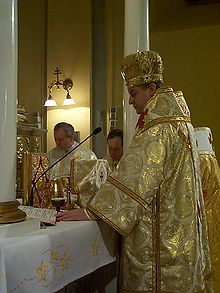Sakkos
Traditionally, bells are attached to the sakkos, following the biblical directions for the vestments of the Jewish High Priest (Exodus 28:33–34; 39:25–26).
Originally, all bishops wore a phelonion similar to the one worn by priests, but woven or embroidered with a multilayered cross pattern called the polystaurion ("many-crosses").
The use of the sakkos was a privilege bestowed by the Basileus (Emperor) upon individual patriarchs as a sign of his personal favor.
The first artistic depiction of the sakkos is in a portrait of an archbishop in Peribleptos, Orchid, and then in a fresco of Sava of Serbia found in Our Lady of Ljeviš, Prizren.
[2] The spread of the sakkos paralleled that of the along with the mitre, derived from the Imperial crown, as a sign of their temporal authority within the Rum millet of the Ottoman Empire.
At other services, he will wear the episcopal mantle (Greek: Μανδύας, Mandýas, Old Church Slavonic: Mantiya).
He blesses it with both hands, and two subdeacons lift it off the tray, hold it for him to kiss the cross on the back, place it on him and button the sides (as shown here).
This was also the period in which Orthodox Bishops began wearing imperial mitres and also were seated on a throne off to the side, rather than the center near where the original ambo would have been.




